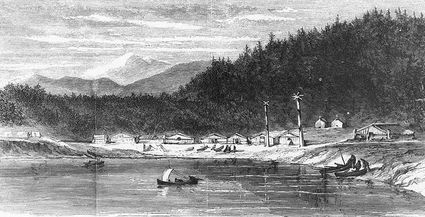Jones in Wrangell to study 1869 Bombardment

Greg Knight
Researcher Zach Jones was in the borough last week to dig into the history of the 1869 Bombardment of Wrangell.
Zachary Jones, a historian and archivist for Sealaska Heritage Institute was in Wrangell last week to speak to the public about his ongoing research into documentation of the 1869 Battle of Wrangell.
Jones, a Ph.D. candidate in Ethnohistory at University of Alaska Fairbanks, has worked for Sealaska for five years as a curator on Native artifacts. His current studies involve the conflict between U.S. Army soldiers stationed at Fort Wrangell and the local Tlingit people. The study is being funded by SHI and a grant from the National Park Service American Battlefield Preservation Program.
According to a report compiled by Vincent Colyer, Secretary to President Ulysses S. Grant, on Christmas night in 1869, just over a year after Alaska became a U.S. Territory, a member of the Stikine tribe bit off the finger of a white woman. The stunt eventually led to the deaths of two Stikine men, a white male killed in retaliation named John Smith, and saw the military threatening to completely destroy Fort Wrangell until Smith’s murderer was captured and hanged.
The Native version of the story differs markedly, however, from what the others have contended. According to both written and oral history, there was a Native eyewitness whose words were taken down and preserved.
William Tamaree, who was six years old when the 1869 battle occurred, told his story to Sentinel publisher Wilfred Williams in 1940. He told Williams that though he was young, he remembered the incident clearly because it had left such a grave impression on him.
According to Tamaree, in the fall of 1869, white soldiers arrived in Wrangell. They hired Natives to cut logs to build a fort where the Federal Building once stood. The soldiers apparently drove the Natives to work very hard on the project and by Christmas they built two log houses and another big house where the U.S. Army Captain lived.
Tamaree’s story stated that there were, “two towns then in Wrangell. One, the white man’s town, the fort, and the other the Indian’s town which is where the sawmill now stands. Shakes Island and across from the island along the curved beach, clear around to the point at the end of the breakwater. There is no main street then in Wrangell.”
On Christmas Eve, as the story goes, the Captain of the fort sent word to all the chiefs of the Native villages, saying “Tonight is Christmas Eve. It is time to be happy. You come up to the fort and be happy and have a good time.”
As the story goes, the Natives asked each other, “What is that for, Christmas Eve? Our interpreter does not know. They have never heard of Christmas… They just know the white chief of the soldiers say it is a time to be happy.”
During the party, at some point, the finger of the Captain’s wife was bitten off in an argument.
Alcohol, and an attempt by one of the soldiers to seduce the wife of a Tlingit man, was reported to be behind the altercation.
Two brothers named Isteen and Chuwan, who were nephews of Towatt, one of the chiefs of the Indian village, were killed later that night by Army officers.
After the killing, Scutdoo, their father and a shaman to the Natives, avenged the death by killing Captain Smith.
The 1940 Sentinel article states “Scutdoo walks. Pretty soon he comes to Smith’s trading post. He sees Smith walking across his porch. Well, here is a white man. Indian’s law says when one of their men is killed by another tribe, other tribe must pay with the life of one of their men. White men have killed Scutdoo’s sons. Here is a white man. So, Scutdoo raises his Hudson Bay gun and shoots. Smith falls dead.”
That was when open warfare broke loose – and the Bombardment of Wrangell began.
The $31,718 grant given to SHI to study the bombardment was one of 27 projects to receive part of the $1.3 million in National Park Service grants which will be used to help preserve, protect, document, and interpret America’s significant battlefield lands.
Anyone with information or oral history related to the bombardment is encouraged to contact Jones via email at zachary.jones@sealaska.com.









Reader Comments(0)